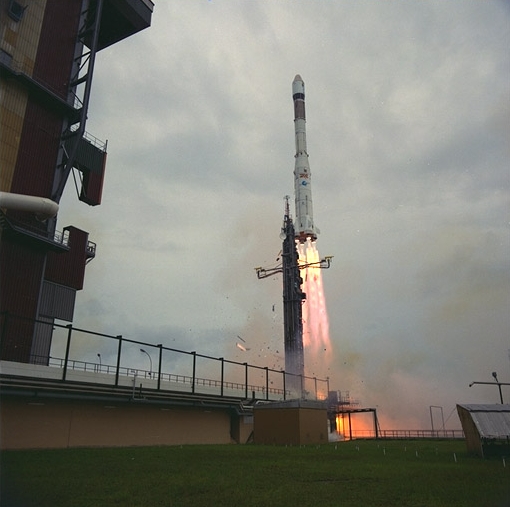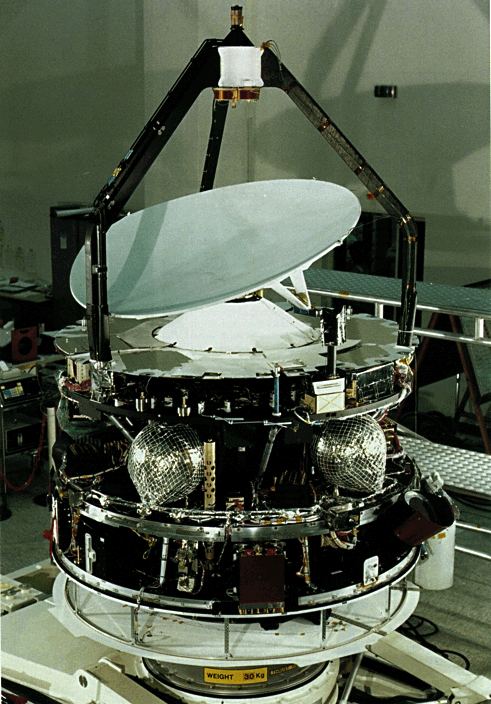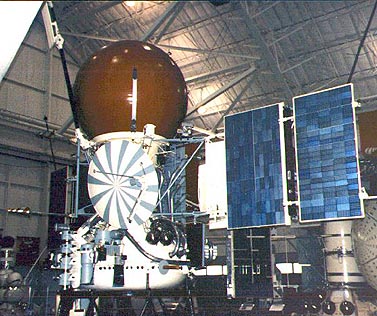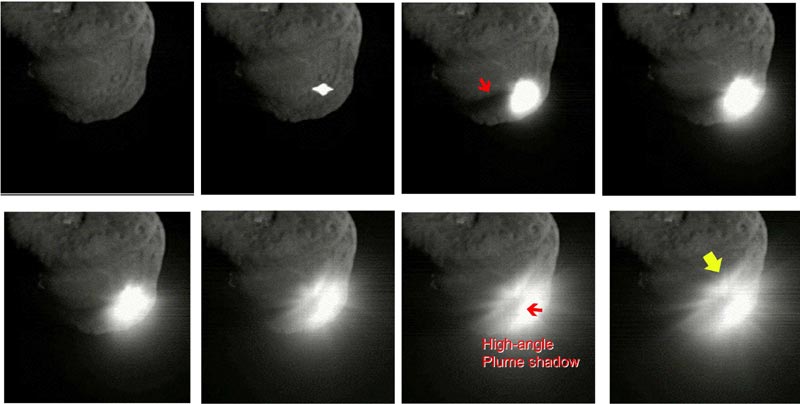The Ancient Solar System - going there.

Image above: One cloudy morning the Giotto spacecraft splits the sky, on the first leg of its 8 year mission to explore comets Halley and Grigg Skjellerup. Image courtesy of ucl.co.uk.
There are many sources of information on our solar systems deep past, but few are as anticipated or as exciting as space missions to explore ancient chunks of matter, like asteroids and comets, left almost unaltered since that time. So lets give our ancient solar system story context, lets tip our hats to, and marvel at, some of these missions to survivors from geologically distant eons.
Past:
First stop in this series, which will run concurrently with the ancient solar system story, are some of the missions that have completed their main objective, furnishing us with stunning images and tantalising data...
1984 and 1985: Giotto and VEGA
Image above: Giotto under construction. Image courtesy of ESA. Image above : A mock up of the Vega spacecraft, which dropped balloon probes on the planet Venus, then went on to Halley's comet. Image courtesy of mentallandscape.com
Image above : A mock up of the Vega spacecraft, which dropped balloon probes on the planet Venus, then went on to Halley's comet. Image courtesy of mentallandscape.com
The first up close and personal glimpse of a wanderer from the deep past was [1]ESAs [2]Giotto mission, which became the first space craft to perform a close fly by of the [3]nucleus of a comet. Sending back incredible images, the little cylindrical robot opened up a whole new vista on these frozen, nomadic, time capsules. The Giotto and [4]VEGA 1 and 2 missions revealed [5]Halleys comet to be a tiny, dark skinned, peanut shaped world, barely 15km from end to end. The VEGA mission found the crust to be almost totally black with a temperature between 300 and 400 degrees kelvin, suggesting it is made of space weathered [6]organic compounds1. Reflectively brilliant jets of water vapour, carbon monoxide, and carbon dioxide burst through the surface, laced with traces of methane and ammonia. Dust particles swept like black bullets away from the surface by the vents were found, from the size of small hailstones down to the smaller than the unaided eye can perceive. These particles contained complex compounds based on carbon, hydrogen, oxygen, and nitrogen, mashed together: The presence of such material has suggested to scientists watching from Earth that comets were a possible source of organic material for pre-biotic chemistry here, billions of years ago. Image above: The nucleus of Haleys comet, a 15km long piece of rock, organic chemicals, and ice broken by jets of evaporating ices. Image courtesy of johnstonarchive.com
Image above: The nucleus of Haleys comet, a 15km long piece of rock, organic chemicals, and ice broken by jets of evaporating ices. Image courtesy of johnstonarchive.com
Giottos visit to the Halleys comet was a perilous one: A piece of gravel, shot away from the comet by the jets, smashed its camera. But, even with an eye put out, Giotto soldiered on to visit another comet, the fainter [7]Grigg-Skjellerup, in 1992.
Giotto and VEGA exceeded expectations, and paved the way for many further missions to small objects.
1996: NEAR
Image above: Technicians at work on the NEAR spacecraft in its clean room. Image courtesy of Aerospace-technology.com
[8]NEAR (Near Earth Asteroid Rendezvous) was the [9]first mission to orbit, and then land on, a near Earth asteroid. The target was [10]433 Eros, one of the first near Earth asteroids discovered. On the way NEAR flew by 253 Mathilde, taking spectacular images:
Image above: The slightly ominous face of 253 Mathilde, a carbon rich main belt asteroid about 66 km across at its widest. The surface is covered in phyllosilicate materials, which often form in relation to liquid water. This image was taken by NEAR from around 2400km. Image courtesy of NASA.
Eros was shown by NEAR to be a tiny, stony, desert 33 km from end to end, with a granite cracking difference in temperature between the night and day side: 250 degrees kelvin (123 kelvin on the night side, 373 kelvin maximum on the day side. The asteroids surface held [11]hard to explain smoothed areas-perhaps related to a collision with another asteroid that sent shock waves through its internals structure, shaking the outer layers of Eros like sand in a 'quake and erasing ancient craters from its records. The mission also revealed Eros to be layered internally, with a solid core topped by rubble from countless collisions and eons of thermal weathering. Image above: The S-type (stony) asteroid Eros looms out of the darkness like an interplanetary whale. Image courtesy of Jet Propulsion Laboratory (JPL) NASA.
Image above: The S-type (stony) asteroid Eros looms out of the darkness like an interplanetary whale. Image courtesy of Jet Propulsion Laboratory (JPL) NASA. Image above: A density map of 433 Eros. Red is denser, shading to dark blue as least dense. Image courtesy of Jet Propulsion Laboratory (JPL) NASA.
Image above: A density map of 433 Eros. Red is denser, shading to dark blue as least dense. Image courtesy of Jet Propulsion Laboratory (JPL) NASA. Image above: Odd 'ponded' regions on Eros, where fine dust appears to have settled into the bottom of craters. This is odd given Eros tiny size and low gravity, and may be related to disturbances from collisions with smaller asteroids. Image courtesy of astro.cornell.edu
Image above: Odd 'ponded' regions on Eros, where fine dust appears to have settled into the bottom of craters. This is odd given Eros tiny size and low gravity, and may be related to disturbances from collisions with smaller asteroids. Image courtesy of astro.cornell.edu
Part of the rationale behind NEAR was that missions like it could literally save our planet: 433 Eros isn't likely to hit Earth, but it is very similar to some that could- and if a vindictive cousin of Eros came calling on our skies one day.... Image above: Depiction of the crater from the blast that wiped out the dinosaurs (or at least a lot of them). I could have put a very dramatic special effect here. I didn't - think about what this picture represents if centered over say, London, Washington, Moscow, Beijing...... special effects would be selling it short.
Image above: Depiction of the crater from the blast that wiped out the dinosaurs (or at least a lot of them). I could have put a very dramatic special effect here. I didn't - think about what this picture represents if centered over say, London, Washington, Moscow, Beijing...... special effects would be selling it short.
Image courtesy of athenapub.com
Knowing how an asteroid like Eros works is a step towards being able to prevent such rare but apocalyptic disasters.
2005: Deep Impact Image above: Ball Aerospace technicians work on the Deep Impact probe. Image courtesy of Ball Aerospace .
Image above: Ball Aerospace technicians work on the Deep Impact probe. Image courtesy of Ball Aerospace . Image above: The battered, alien , surface of Tempel 1 appears out of the darkness as the Deep Impact mission approaches. Image courtesy of NASA.
Image above: The battered, alien , surface of Tempel 1 appears out of the darkness as the Deep Impact mission approaches. Image courtesy of NASA.
The [12]Deep Impact mission could have been subtitled 'Earth strikes back!' as this was a uniquely explosive mission: its goal was to smash a 370 kg copper slug into the surface of comet [13]Tempel 1, pulverizing the crust and ejecting it into space. The blast was equivalent to roughly 5 tons of TNT, and would have given astronomers their first good look at the interior of a comet. Image above: The impact and resulting dust plume from the Deep Impact copper 'bullet' slamming into Tempel 1 at space craft speeds. The resulting crater is obscured by the plume (although probably wouldn't be visible at this resolution anyway). Image courtesy of wvi.com, and JPL NASA.
Image above: The impact and resulting dust plume from the Deep Impact copper 'bullet' slamming into Tempel 1 at space craft speeds. The resulting crater is obscured by the plume (although probably wouldn't be visible at this resolution anyway). Image courtesy of wvi.com, and JPL NASA.
On the 4th of July 2005 the impactor flashed down through the comets rarefied coma, crossing its skies with speed a human eye could not even register, and slammed into the comets fragile crust- but Tempel 1 had the last laugh: the blast threw up a plume of dust so large it totally whited out the blast site! Image above: The plume of dust blasted into space by Deep Impact. From this angle it is clear how extensive the plume is, ad why imaging the impact site is no easy proposition on this pass of the nucleus. Image courtesy of NASA.
Image above: The plume of dust blasted into space by Deep Impact. From this angle it is clear how extensive the plume is, ad why imaging the impact site is no easy proposition on this pass of the nucleus. Image courtesy of NASA.
Still, observations of the dust cloud found some surprising things: Tempel 1 contained less water than expected, and held [14]phyllosilicates, [15]carbonates, (both often formed by liquid water), metal sulfides (like fools gold), sodium (a rare find in space), and Polycyclic Aromatic Hydrocarbons ([16]PAHs) which some theories implicate in the origins of life.
And as for that crater? It is thought to be about 100 meters wide, 30 deep, and not to worry- [17]Stardust NExT is due to drop by Tempel 1 in 2011 to get a better look at it. Meanwhile the main Deep Impact spacecraft has been assigned two new missions: using one of its cameras to study distant [18]extrasolar planets, and a visit to comet [19]Hartley 2 this November.
1999: Stardust Image above: The Stardust spacecraft is inspected. Image courtesy of Life magazine.
Image above: The Stardust spacecraft is inspected. Image courtesy of Life magazine.
Bringing us to the [20]Stardust mission, which I have written about numerous times before. Stardust's first mission was to comet [21]Wild 2. Wild 2 is believed to be newcomer in the warmer inner solar system, and has spent most of its existence in the frigid volumes of the outer solar system space until the huge gravity of Jupiter rudely perturbed it. Image above: The nucleus of wild 2, an alien landscape of towering spires, steep sided pits and twisted canyons. Image courtesy of NASA.
Image above: The nucleus of wild 2, an alien landscape of towering spires, steep sided pits and twisted canyons. Image courtesy of NASA.
Early in 2004 the small ship flew through the coma of Wild 2 and collected samples of the dust in specially designed [22]aerogel collectors. On the 15th of January 2006 [23]it faithfully delivered its sample capsule into Earths atmosphere, and continued on to become the stardust NExT mission. Image above: Stardusts sample return capsule safely on the ground after the nail biting tension of re-entry. Image courtesy of the Open University.
Image above: Stardusts sample return capsule safely on the ground after the nail biting tension of re-entry. Image courtesy of the Open University. Image above: Tracks from the 6km/second impact of particles with the aerogel collector on Stardust. The particle's themselves are trapped in the bulb shaped track ends. Image courtesy of JPL NASA.
Image above: Tracks from the 6km/second impact of particles with the aerogel collector on Stardust. The particle's themselves are trapped in the bulb shaped track ends. Image courtesy of JPL NASA.
Studies of these samples have revealed a range of organic molecules, including [24]remarkably long chain hydrocarbons and [25]glycine a fundamental building block of proteins. High temperature materials such as olivine and pyroxene, that suggest some unknown mixing mechanism was at work in the early solar system, were also found. The results add to the mystery of cometary water, as Wild 2 seems to have little in the way of carbonates, unlike other comets studied. To top all this off, one very special grain dubbed [26]'Orion' by its stardust@home discoverer, may be from a lot further away than anything else ever recognized by human eyes: a grain from interstellar space.
The chemistry was not the only fascinating result: Wild 2 was revealed to be one of the most alien landscapes ever seen: A bizarrely folded place of scarps, spires and degraded depressions. Pillars of vapour from vents stud the landscape, and a truly alien geology with no simple analogue on Earth at play here.
2003: Hayabusa, Per Ardua Ad Astra.
In the recent past one mission has stood out, for sheer drama and nail biting intensity- and for the tenacity and inventiveness of the mission control team here on earth:
[27]JAXAs [28]Hayabusa space craft. If ever a mission deserved the title of 'the little ship that could' it’s this one.
The mission launched aboard an [29]M-V rocket on the 9th of may 2003. The 520 kg probe was equipped with four ion engines, powered by large solar panels, and carried the tiny [30]MINERVA lander. This was the first attempt by humans to land a probe on the surface of an asteroid, collect samples, and then return them to Earth. The craft itself was a testbed for several new technologies, including the [31]ion engines themselves.
But only months after launch, while still en-route, [32]a monster solar flare struck the spacecraft, frying its solar panels, and reducing the power available to the ion drives. The damage wasn't lethal, but the limping probe couldn't reach the asteroid by its scheduled June 2005 date, and instead had to wait until September to rendezvous. Since orbital mechanics demanded that the probe leave the asteroid by November 2005 to reach Earth, the amount of time the probe could spend at the [33]Itokawa asteroid was cut in half. Image above: As Hayabusa approaches the surface of Itokawa his (Japenese ships are 'he') shadow is cast by the distant sun onto the regolith beneath him. image courtesy of JAXA.
Image above: As Hayabusa approaches the surface of Itokawa his (Japenese ships are 'he') shadow is cast by the distant sun onto the regolith beneath him. image courtesy of JAXA.
A hard road....:
When the probe struggled eventually into a sun centred station keeping orbit, 20km off Itokawas surface, the probe began mapping the surface using infra red and x-ray spectrometers. But when it tried to launch the coffee jar sized MINERVA lander catastrophe struck: a problem with the spacecrafts navigation sent the little lander tumbling into deep space.
[34]Glitches plagued the mission: A navigation problem left the probe stranded on the asteroids baking surface for 30 minutes, over heating it. A propellant tank began to leak, an onboard battery discharged its power threatening the spacecrafts systems, the sample collecting system malfunctioned, and the probes small chemical engine was catastrophically damaged during a landing attempt.
Some of the malfunctions began to threaten the probes ability to return to Earth: two of the reaction control fly wheels used by the probe to orient itself had jammed, and then the ion engines, one of which was already found to be unstable shortly after launch, began to give out.
The Hayabusa team refused to say die: they compensated for the loss of one fly wheel by orienting the craft using its ion engines and for the loss of the other by inventively using [35]solar sailing. As the conditions of the ion engines worsened the team began a running battle to keep at least two working, eventually resorting to [36]using the undamaged parts of two malfunctioning thrusters together, as one cobbled together engine.
After seven years in space, in a testament to the strength of will and ingenuity of the ground team and the tenaciousness of the little probe, [37]Hayabusa delivered its sample return capsule to Earth on the 13 of June 2010 before being immolated in Earths atmosphere. Japanese scientists are still studying the small amount of material in the capsule to determine if it is indeed material from the asteroid, so stay tuned for news on that front. Image above: Hayabusa splits open the night sky over the Australian desert, literally going down in flames to bring its cargo home Image courtesy of National Geographic.
Image above: Hayabusa splits open the night sky over the Australian desert, literally going down in flames to bring its cargo home Image courtesy of National Geographic.
A surprising find: Image above: Itokawa, a rubble pile that should not by rights have been able to form and hold together. Image courtesy of JAXA.
Image above: Itokawa, a rubble pile that should not by rights have been able to form and hold together. Image courtesy of JAXA.
The mission revealed Itokawa itself to be something very different than the image of a single huge cratered rock many were expecting. Itokawa was shown to be a 535m by 209m by 294 m pile of [38]iron and magnesium silicates, and seems to be a rubble pile, made from smaller asteroids which have come together and stuck. [39]The surface is a mixture of broken up rock, pebble and boulders with [40]odd smooth patches, and its density is way to low for it to be solid rock- it must be filled with caverns. This information is vital baseline data for future asteroid missions, as well as any attempt to move or destroy an asteroid on a collision course with Earth. And if even a tiny amount of its surface has been captured we can use more powerful instruments on earth to learn about how this lonely rock and others like it came to be, hence shedding further light on how rocky bodies that went toward building Earth were born.
Recently JAXA has announced that Hayabusa 2 has been greenlighted, and that it will be headed to asteroid [41] 1999JU3- a [42]c type asteroid that may have a history of organic chemistry and alteration by water, so watch this space eagerly!
List of links:
[1]www.esa.int/esaCP/index.html
[2]http://sci.esa.int/science-e/www/area/index.cfm?fareaid=15
[3]http://www.weather.gov.hk/gts/event/event-comet_e.htm
[4]http://starbrite.jpl.nasa.gov/pds/viewMissionProfile.jsp?MISSION_NAME=VEGA%201
[5]http://www.solarviews.com/eng/halley.htm
[6]http://www.organic-chemistry.org/
[7]http://sci.esa.int/science-e/www/object/index.cfm?fobjectid=31877
[8]http://near.jhuapl.edu/
[9]http://nssdc.gsfc.nasa.gov/planetary/near.html
[10]http://astroprofspage.com/archives/1508
[11]http://www.nature.com/nature/journal/v436/n7049/full/nature03855.html
[12]http://www.nasa.gov/mission_pages/deepimpact/main/
[13]http://www.planetary.org/explore/topics/asteroids_and_comets/tempel1.html
[14]http://ssed.gsfc.nasa.gov/gunther/gunther/lisseetal2007.pdf
[15]http://www.lpi.usra.edu/meetings/acm2008/pdf/8382.pdf
[16]http://www.space.com/scienceastronomy/051018_science_tuesday.html
[17]http://stardustnext.jpl.nasa.gov/
[18]http://planetquest.jpl.nasa.gov/
[19]http://www.sciencedaily.com/releases/2007/12/071215203737.htm
[20]http://stardust.jpl.nasa.gov/photo/top20.html
[21]http://www.solarviews.com/eng/cometwild2.htm
[22]http://stardust.jpl.nasa.gov/tech/aerogel.html
[23]http://www.space.com/missionlaunches/0601_stardust_archive.html
[24]http://infrared.als.lbl.gov/pubs/Stardust-IR-Science2006.pdf
[25]http://science.gsfc.nasa.gov/691/analytical/PDF/Elsila2009.pdf
[26]http://www.nature.com/news/2010/100303/full/news.2010.106.html
[27]http://www.jaxa.jp/index_e.html
[28]http://www.isas.jaxa.jp/e/enterp/missions/hayabusa/index.shtml
[29]http://www.isas.jaxa.jp/e/enterp/rockets/vehicles/m-v/index.shtml
[30]http://www.planetary.org/explore/topics/hayabusa/facts.html
[31]http://www.bbc.co.uk/science/space/exploration/futurespaceflight/ionengines.shtml
[32]http://www.space.com/scienceastronomy/xtreme_flare_031105.html
[33]http://www.newscientist.com/article/dn9257-rubbly-itokawa-revealed-as-impossible-asteroid.html
[34]http://www.planetary.org/blog/article/00002530/
[35]http://5thstar.air-nifty.com/blog/2009/02/hayabusas-retur.html
[36]http://www.nasa.gov/offices/oce/appel/ask-academy/issues/volume3/AA_3-6_F_outside.html
[37]http://www.universetoday.com/66330/hayabusa-returns/
[38]http://www.spaceref.com/news/viewpr.html?pid=19991
[39]http://www.jaxa.jp/article/special/hayabusa_sp3/index_e.html
[40]http://www.planetary.org/blog/article/00000969/
[41]http://www.lpi.usra.edu/meetings/lpsc2008/pdf/1594.pdf
[42]http://www.planetary.org/explore/topics/asteroids_and_comets/facts.html
No comments:
Post a Comment